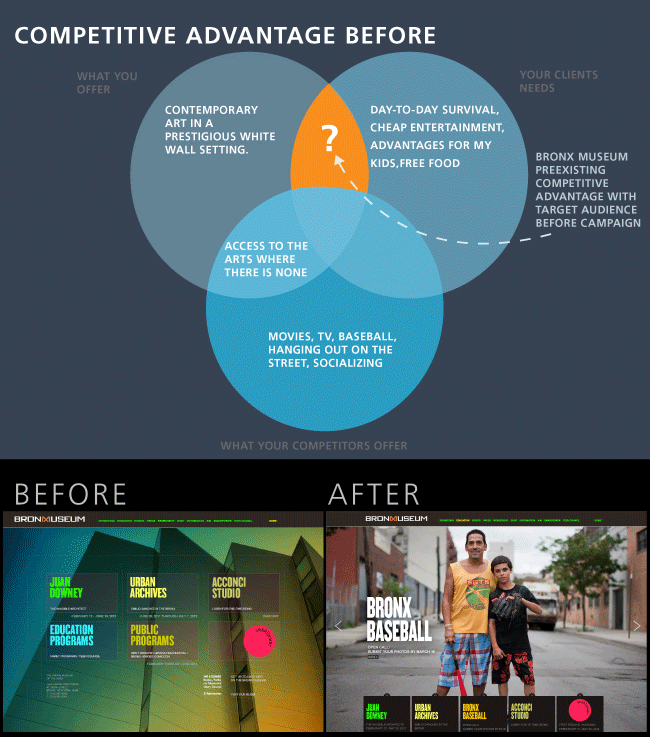What is marketing strategy?
Let’s have 30 seconds of silence.
That was your marketing message without a strategy.
That 30 seconds of silence is what people effectively get out of your communications if your message does not directly address their needs. As Howard Gossage has so aptly pointed out, people see or hear only what interests them. The rest is, well, nothing.
Consumers do not buy what you sell. They buy what has value to them.
We are exposed to hundreds, if not thousands, of marketing messages every day. Why would we be receptive to all of them? That would be mental chaos. So, in response, we tune out all but the most relevant ones. Our brain is actually very good at tuning out stuff that it does not want or need. We do this automatically. This prevents us from going insane.
You probably remember the experience of learning a new word—as a child or even as an adult—and all of a sudden you see and hear that word everywhere. This is an example of how our brains smooth over the parts of our environment that are not relevant to us. That word was always there, of course, but it was effectively invisible to our mind until learning its meaning gave it relevance. As a result, pop! like magic that word is now there where seemingly it never was before. A marketing message operates exactly the same way.
What does marketing strategy have to do with this materialization out of nothing?
Marketing strategy is sorting out who your audience actually is, and then finding out what has meaning for them. What do they care about, and how does this relate to your offer? What message can you deliver that is both true and meets your consumer squarely at the level of their needs? Marketing strategy is the process of uncovering messages that can be heard. Marketing strategy allows you to answer the crucial question your offer must address: “Why should I care?” To paraphrase Peter Drucker: Consumers do not buy what you sell. They buy what has value to them.
Why does marketing strategy matter?
Shortest answer: Because it saves you money.
Marketing strategy allows you to use pathways and footholds that apply your limited marketing budget more effectively.
In marketing, there is strategy and there are tactics. A lot of marketing, in practice, is preoccupied with what I call tactical experimentation. This is the act of throwing all kinds of things out at the world or at broad demographic targets to see what works. As you do this you are spending money, potentially lots of it. The idea in this method is to do this until you find some marketing actions that work, and when you find them you can then do more of those.
This process often results in the classic Wanamaker dilemma—”Half the money I spend on advertising is wasted; the trouble is I don’t know which half.” He was speaking of advertising, but the principle applies.
Marketing strategy allows you to use pathways and footholds that apply your limited marketing budget more effectively (everyone’s marketing budget is limited). Marketing strategy facilitates your ability to apply marketing money to the correct half of the Wanamaker equation—the half you are not wasting on audiences who do not value your message.
To illustrate this principal with one of our own rather straightforward examples, when we looked at the South Bronx as a marketplace for the Bronx Museum, the situation we saw was reflected by the first competitive advantage diagram below; here, there is nothing in their offer, as understood by the consumer, that is of any perceived value. The strategy, therefore, could not be to simply support the institutional desire to communicate about all the great art that was on exhibit (see Drucker above).
We had to find factors that could legitimately be moved into the competitive advantage, things that were perceived as valuable to the desired audience, that were not perceived to be offered by the competition. In this case, there was no required product change, just an adjustment of the marketing message communicated through the website and advertising. By effectively marketing on the basis of the factors that reflected what was of value to the target consumer we cost-effectively supported the achievement of their desired objective to increase attendance from local audiences in the South Bronx. This is marketing strategy applied, and it helped them double attendance*. (You can read more about this campaign in The Marketing of the Bronx Museum.)
So, for the sake of your own institution or product, please spend the time and energy to really get inside the head of your consumer. Find the intersection between your offer and their needs. Answer Drucker’s Questions #2 and #3: Who is your customer? What do they value? Isolate those specific factors that actually drive behavior for them. Realize they are not buying what you are selling, they are only buying what is of value to them. And, by all means, use THAT in your marketing communications.
You’ll be very glad you did.
If what I’m describing makes sense, if you understand that strategy saves you money, and you need help sorting out the situation for your particular marketplace, please consider one of our Strategy Workshops.
Do you need an affordable way to improve your brand today?
Because we know that not everyone needs or can afford our full process, we created a guided tutorial package for our foundational brand strategy tool: the Brand Pyramid. Watch the video for a preview.
For more information on the brand strategy tutorial, visit here where you will find a fuller explanation and link to a free download of the first video.





To complete this discussion post, I first asked myself, what is a marketing strategy? In searching on that question, I stumbled across the same question James Heaton (2013), President & Creative Director of Tronvig Group asked too, in which he replied, “Let’s have 30 seconds of silence.” —“That was your marketing message without a strategy.” Heaton went on to explain that if your message does not directly address their needs, they would effectively get these seconds of nothing. Many years ago, Magic Johnson stressed the very same thing during an interview, which is business owners have to focus on addressing the needs of people they are attempting to serve in order to be effective at serving them. In summary, a marketing strategy is sifting out who is your audience, finding out what they need, what has meaning or value to them, and then determining how it relates to what you offer.